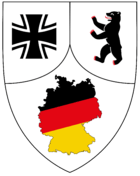Joint Support Service (Germany)
| Joint Support Service | |
|---|---|
| Streitkräftebasis | |
 Logo of the Streitkräftebasis | |
| Active | 1 October 2000 |
| Country | Germany |
| Size | 41,092 personnel (16 December 2016)[1] |
| March | "Marsch der Streikräftebasis"[2] |
| Website | http://www.streitkraeftebasis.de/ |
| Commanders | |
| Inspector | Generalleutnant Martin Schelleis (German Air Force) |
| Deputy Inspector | Generalleutnant Peter Bohrer (German Air Force) |
| Chief of Staff | Generalmajor Jürgen Setzer (German Army) |
| Notable commanders | Manfred Nielson, Wolfram Kühn |
.jpg)
The Joint Support Service (German: Streitkräftebasis, SKB, literally Armed Forces Foundation) is a branch of the German Bundeswehr established in October 2000 as a result of major reforms of the Bundeswehr. It handles various logistic and organisational tasks of the Bundeswehr. The SKB is the fifth component of the Bundeswehr, the other four being the Army, Navy, Air Force and the Joint Medical Service. As of December 2016, the force is composed of around 41,100 personnel.
Organization
Unlike the similar British Defence Logistics Organisation and the Australian Department of Defence's Support Command Australia, Germany's current military environment has led to a number of combat-associated commands being allotted to it, principally the small German territorial defence structure embodied in the four Wehrbereichskommandos (Military District Commands), and the national supervision of active German military operations beyond the NATO area, performed by the Einsatzführungskommando (Bundeswehr Operations Command), which is headquartered in Potsdam.
The WBK headquarters are in:
Each Military District Command controls several Landeskommandos (State Commands) due to the federal structure of Germany. Previously this function was carried out by the Verteidigungsbezirkskommandos (VBKs) or Military Region Commands (Defence District Commands). These command authorities are in charge of all military facilities in their area of responsibility and of several supporting regiments. The SKB was formed on the basis of the former IV (GE) Korps. Most of its remaining elements have been reassigned from the Central Military Agencies of the Bundeswehr, encompassing a wide range of logistics agencies, schools, and other support units.
The top command authorities are the Kommando Streitkräftebasis (Joint Support Service Command) which is in charge of numerous of command and control roles. The Streitkräfteamt (Armed Forces Office) directs all schools, training and research centres, the Military Counterintelligence Service (Militärischer Abschirmdienst), and the Bundeswehr's higher academies and universities.
Structure
| |||||||||||||||||||
- Joint Support and Enabling Service Headquarters, in Bonn[3]
- Multinationale Kommando Operative Führung/Multinational Joint Headquarters Ulm, in Ulm
- Military Studies Office, in Munich
- Federal Security Policy Academy, in Berlin
- German Military Representative at NATO & EU, in Brussels
Logistic Command






.png)



Military Police Command

CBRN-defense Command

Territorial Tasks Command














.jpg)

- Bundeswehr Civil-Military Cooperation Centre, in Nienburg
- Guard battalion at the Ministry of Defence, in Berlin
- All Bundeswehr Training Areas, divided into three regions (North, South, East)
Armed Forces Office
- Armed Forces Office, in Bonn
- Bundeswehr Verification Tasks Centre, in Geilenkirchen
- Bundeswehr Service Dog School, in Ulmen
- Bundeswehr Public Relations Centre, in Strausberg
- Bundeswehr Military Music Centre, in Bonn
- Bundeswehr Sport School, in Warendorf
References
- Notes
- ↑ "Stärke: Militärisches Personal der Bundeswehr". Bundeswehr (in German). 16 December 2016. Retrieved 18 December 2016.
- ↑ Kirschner, Claus-Dieter (1 October 2010). "Der große Erfolg von Gerhard Fetzer". Heidenheimer Zeitung (in German).
- ↑ "Organisation Streitkräftebasis". Bundeswehr. Retrieved 19 July 2018.


